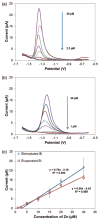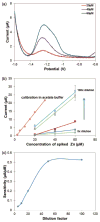Improving Reproducibility of Lab-on-a-Chip Sensor with Bismuth Working Electrode for Determining Zn in Serum by Anodic Stripping Voltammetry
- PMID: 24729629
- PMCID: PMC3980724
- DOI: 10.1149/2.022402jes
Improving Reproducibility of Lab-on-a-Chip Sensor with Bismuth Working Electrode for Determining Zn in Serum by Anodic Stripping Voltammetry
Abstract
This work reports on the continuing development of a lab-on-a-chip electrochemical sensor for determination of zinc in blood serum using square wave anodic stripping voltammetry. The microscale sensor consists of a three electrode system, including an environmentally friendly bismuth working electrode, an integrated silver/silver chloride reference electrode, and a gold auxiliary electrode. The sensor demonstrates a linear response in 0.1 M acetate buffer at pH 6 for zinc concentrations in the 1-30 μM range. By optimizing bismuth film deposition and better control of the fabrication process, repeatability of the sensor was improved, reducing variability from 42% to <2%. Through optimization of electrolyte and stripping voltammetry parameters, limit of detection was greatly improved to 60 nM. The optimized sensor was also able to measure zinc in the extracted blood serum. Ultimately, with integrated sample preparation, the sensor will permit rapid (min) measurements of zinc from a sub-mL sample (a few drops of blood) for clinical applications.
Figures








Similar articles
-
Lab-on-a-Chip Sensor with Evaporated Bismuth Film Electrode for Anodic Stripping Voltammetry of Zinc.Electroanalysis. 2013 Dec;25(12):2586-2594. doi: 10.1002/elan.201300349. Electroanalysis. 2013. PMID: 24436575 Free PMC article.
-
Zinc Detection in Serum by Anodic Stripping Voltammetry on Microfabricated Bismuth Electrodes.Electroanalysis. 2013 Feb;25(2):10.1002/elan.201200530. doi: 10.1002/elan.201200530. Electroanalysis. 2013. PMID: 24235807 Free PMC article.
-
Lab-on-a-chip sensor for detection of highly electronegative heavy metals by anodic stripping voltammetry.Biomed Microdevices. 2011 Aug;13(4):695-703. doi: 10.1007/s10544-011-9539-1. Biomed Microdevices. 2011. PMID: 21479538 Free PMC article.
-
A rime ice-inspired bismuth-based flexible sensor for zinc ion detection in human perspiration.Mikrochim Acta. 2021 Feb 23;188(3):97. doi: 10.1007/s00604-021-04752-x. Mikrochim Acta. 2021. PMID: 33620589
-
A mercury-free electrochemical sensor for the determination of thallium(I) based on the rotating-disc bismuth film electrode.Talanta. 2007 Jun 15;72(4):1392-9. doi: 10.1016/j.talanta.2007.01.047. Epub 2007 Jan 30. Talanta. 2007. PMID: 19071774
Cited by
-
Simultaneous quantification of Cd(II) and Pb(II) in surface marine sediments using Ag-Hg and Ag-Bi nanoalloys glassy carbon modified electrodes.Heliyon. 2021 May 29;7(5):e07120. doi: 10.1016/j.heliyon.2021.e07120. eCollection 2021 May. Heliyon. 2021. PMID: 34136693 Free PMC article.
-
Determination of manganese by cathodic stripping voltammetry on a microfabricated platinum thin-film electrode.Electroanalysis. 2017 Mar;29(3):686-695. doi: 10.1002/elan.201600679. Epub 2017 Jan 26. Electroanalysis. 2017. PMID: 28983182 Free PMC article.
References
-
- Smith JC, Butrimovitz GP, Purdy WC. Clin Chem. 1979;25(8):1487. - PubMed
-
- Rahman S, Waheed S. J Radioanal Nucl Ch. 2009;279(3):915.
-
- Jenner GA, Longerich HP, Jackson SE, Fryer BJ. Chem Geol. 1990;83(1–2):133.
-
- Barany E, Bergdahl IA, Schütz A, Skerfving S, Oskarsson A. J Anal Atom Spectrom. 1997;12(9):1005.
-
- Wang J. Analytical Electrochemistry. John Wiley & Sons, Inc; Hoboken, New Jersey, USA: 2006.
Grants and funding
LinkOut - more resources
Full Text Sources
Other Literature Sources
Miscellaneous
